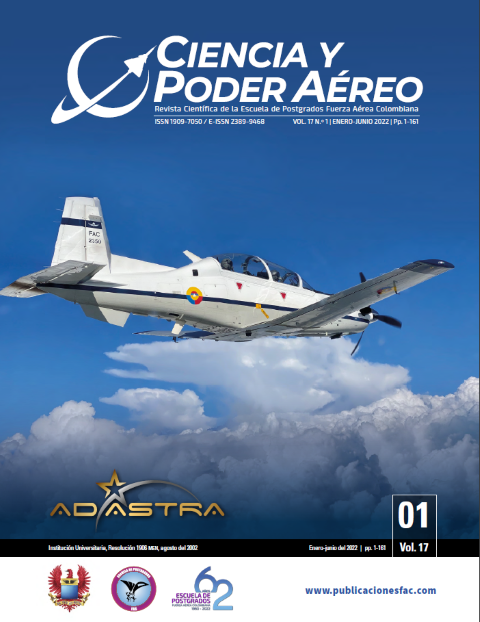Decision-making model for maintenance, repair and operations materials (MRO)
DOI:
https://doi.org/10.18667/cienciaypoderaereo.722Keywords:
inventory management, MRO materials, strategic decision makingAbstract
To optimize inventory management in companies that have a large variety of references, it is necessary to involve maintenance programs in the general strategy of the organization. This includes considering the peculiarities of all types of articles, especially maintenance, repair, and operations materials (MRO). These materials will be the focus of analysis in this study because they occupy a large part of the inventory warehouses in companies and, therefore, represent a large percentage of business costs. This study addresses the case of a organization that contains a large number of items of this nature and elevates associated costs. The main objective is to find the most suitable model to manage them, by defining an algorithm that weighs all the parameters considered important for decision-making, which allow concluding that improving some factors, such as the Lead Time, is more relevant to the savings of the company than the definition of a complex inventory model.
Downloads
References
Adur Kannan, B., Kodi, G., Padilla, O., Gray, D. y Smith, B. C. (2020). Forecasting spare parts sporadic demand using traditional methods and machine learning-a comparative study. SMU Data Science Review, 3(2), 9. https://scholar.smu.edu/datasciencereview/vol3/iss2/9/
Ali, U., Salah, B., Naeem, K., Khan, A. S., Khan, R., Pruncu, C. I., Abas, M. y Khan, S. (2020). Improved MRO inventory management system in oil and gas company: Increased service level and reduced average inventory investment. Sustainability, 12(19), 8027. https://www.mdpi.com/2071-1050/12/19/8027
Amirkolaii, K. N., Baboli, A., Shahzad, M. K. y Tonadre, R. (2017). Demand forecasting for irregular demands in business aircraft spare parts supply chains by using artificial intelligence (AI). IFAC-PapersOnLine, 50(1), 15221-15226. https://doi.org/10.1016/j.ifacol.2017.08.2371
Avery, S. (2006). More ammunition for outsourcing MRO. Purchasing, 135(5), 36-37. https://www.beroeinc.com/whitepaper/mro-distributors-vs-mro-integrators/
Bacchetti, A. y Saccani, N. (2012). Spare parts classification and demand forecasting for stock control: investigating the gap between research and practice. Omega, 40(6), 722-737. https://doi.org/10.1016/j.omega.2011.06.008
Betancourt, D. F. (2018). Sistema de revisión continua de inventarios: definición, métodos y ejemplos. https://www.ingenioempresa.com/sistema-de-revision-continua/
Boylan, J. E. y Syntetos, A. A. (2008). Forecasting for inventory management of service parts. Complex system maintenance handbook (K. A. Helmy Kobbacy y D. N. Prabhakar Murthy (eds.); pp. 479-506). Springer.
Cao, L. I. y Fuzeto, A. P. (2017). Inventory management model: A case study at a metallurgical company in the interior of the state of São Paulo. Revista Produção em Destaque, 1(1), 15-37. https://www.unifafibe.com.br/revistasonline/arquivos/revistaproducaoemdestaque/sumario/53/22052019162344.pdf
Chen, J., Gusikhin, O., Finkenstaedt, W. y Liu, Y.-N. (2019). Maintenance, repair, and operations parts inventory management in the era of industry 4.0. IFAC-PapersOnLine, 52(13), 171-176. https://doi.org/10.1016/j.ifacol.2019. 11.171
Conceição, S. V., Da Silva, G. L. C., Lu, D., Nunes, N. T. R. y Pedrosa, G. C. (2015). A demand classification scheme for spare part inventory model subject to stochastic demand and lead time. Production Planning & Control, 26(16), 1318-1331. https://doi.org/10.1080/09537287.2015.1033497
Coyle, J. J., Bardi, E. J. y Langlay, C. J. (2003). The management of business logistics. A. supply chain perspective. South-Western College Pub.
Gan, S., Zhang, Z., Zhou, Y. y Shi, J. (2015). Joint optimization of maintenance, buffer, and spare parts for a production system. Applied Mathematical Modelling, 39(19), 6032-6042. https://doi.org/10.1016/j.apm.2015.01.035
García-Sabater, J. P., Cardós Carboneras, M., García Sabater, J. J. y Albarracín Guillem, J. M. (2020). Gestión de stocks de demanda independiente. Editorial Universitat Politècnica de València.
Garrido Bayas, I. Y. y Cejas Martínez, M. (2017). La gestión de inventario como factor estratégico en la administración de empresas. Negotium: Revista de Ciencias Gerenciales, 13(37), 109-129. https://www.redalyc.org/articulo.oa?id=78252811007
Hamad, R. y Fares Gualda, N. D. (2011). Modelagem de redes logísticas com custos de inventário calculados a partir da cobertura de estoque. Production, 21(4), 667-675. https://doi.org/10.1590/S0103-65132011005000011
Huiskonen, J. (2001). Maintenance spare parts logistics: Special characteristics and strategic choices. International Journal of Production Economics, 71(1-3), 125-133. https://doi.org/10.1016/S0925-5273(00)00112-2
Kotsifaki, M., Dimitriadis, N., Ketikidis, P. H. y Missopoulos, F. (2007). Logistics strategic planning: Current status and future prospects in Greek companies. International Journal of Risk Assessment and Management, 7(1), 44-58. https://doi.org/10.1504/IJRAM.2007.011409
Ling, L., Liu, M., Shen, W. y Cheng, G. (2017). An improved stochastic programming model for supply chain planning of mro spare parts. Applied Mathematical Modelling, 47, 189-207. https://doi.org/10.1016/j.apm.2017.03.031
Roebuck, B. (2011). Maintenance repair overhaul. Machinery and Equipment MRO.
Saunders, M. J. (Ed.). (1997). Strategic purchasing and supply chain management. Financial Times Pitman.
Sharma, R. y Govindaraju, N. (2020). Maintenance planning activity using intelligent support system. International Journal of Mechanical Engineering, 5(2), 83-88. https://kalaharijournals.com/resources/ijme%20v5-2-7.pdf
Suárez-Cervera, M. L. (2012). Gestión de inventarios: una nueva fórmula de calcular la competitividad. Ad-Quelite.
Downloads
Published
Issue
Section
License
Copyright (c) 2022 Escuela de Postgrados de la Fuerza Aérea Colombiana

This work is licensed under a Creative Commons Attribution 4.0 International License.
Assignment of Copyrights
Authors assign Ciencia y Poder Aéreo journal the exclusive rights (reproduction, distribution, public communication, and transformation) to exploit and commercialize their work, in whole or in part, in all the formats and modalities of present or future exploitation, in all languages, throughout the life of the work and throughout the world.
All contents published in Ciencia y Poder Aéreo journal are licensed under a Creative Commons Attribution 4.0 International License, whose complete information is available at http://creativecommons.org/licenses/by/4.0/
Under the terms of this license, users are free to download, print, extract, archive, distribute and publicly communicate the content of articles, provided that proper credit is granted to authors and Ciencia y Poder Aéreo, scientific journal of the Graduate School of the Colombian Air Force. Except when otherwise indicated, this site and its contents are licensed under a Creative Commons Attribution 4.0 International License.
For other uses not considered under this license it is required to contact the Director or the Editor of the journal at the e-mail address cienciaypoderaereo1@gmail.com.
The Graduate School of the Colombian Air Force and this publication are not responsible for the concepts expressed in the articles, including the metadata or the affiliation stated by authors. This is the full responsibility of the authors.






















